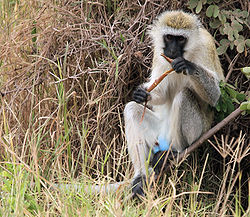The Primates Portal A primate is a member of the biological order Primates, the group that contains lemurs, the aye-aye, lorisids, galagos, tarsiers, monkeys, and apes, with the last category including great apes. With the exception of humans, who inhabit every continent on Earth, most primates live in tropical or subtropical regions of the Americas, Africa and Asia. Primates range in size from the 30-gram (1 oz) pygmy mouse lemur to the 200-kilogram (440 lb) mountain gorilla. According to fossil evidence, the primitive ancestors of primates may have existed in the late Cretaceous period around 65 mya (million years ago), and the oldest known primate is the Late Paleocene Plesiadapis, c. 55–58 mya. Molecular clock studies suggest that the primate branch may be even older, originating in the mid-Cretaceous period around 85 mya. Primates exhibit a wide range of characteristics. Some primates do not live primarily in trees, but all species possess adaptations for climbing trees. Locomotion techniques used include leaping from tree to tree, walking on two or four limbs, knuckle-walking, and swinging between branches of trees (known as brachiation). Primates are characterized by their large brains relative to other mammals. These features are most significant in monkeys and apes, and noticeably less so in lorises and lemurs. Many species are sexually dimorphic, which means males and females have different physical traits, including body mass, canine tooth size, and coloration.
Selected article
Slow lorises are threatened by deforestation and the wildlife trade, including the exotic pet trade, traditional medicine, and bushmeat. Because of these and other threats, such as habitat fragmentation, selective logging, and slash and burn agriculture, slow lorises (genus Nycticebus) are listed as either "Vulnerable" or "Endangered" by the International Union for Conservation of Nature (IUCN). Their conservation status was originally listed as "Least Concern" in 2000 because of the frequency in which these primates were found in animal markets and imprecise population surveys. Because of their rapidly declining populations and local extinctions, their status was updated and in 2007 CITES elevated them to Appendix I, which prohibits international commercial trade. Local laws also protect slow lorises from hunting and trade, but enforcement is lacking in most areas.
Slow lorises have been a part of the traditional beliefs of Southeast Asia for at least several hundred years. Their remains are buried under houses and roads to bring good luck, and every part of their body is used in traditional medicine to make everything from love potions to unproven cures for cancer, leprosy, epilepsy, and sexually transmitted diseases. Furthermore, a large number of slow lorises are traded as pets, both locally and internationally. Although it is illegal to import slow lorises for commercial sale, they are popular pets in Japan, the United States, and Europe, largely due to their "cute" appearance, which has been popularized in highly viewed YouTube videos. Captive lorises experience improper care and die from poor nutrition, stress, or infection. Despite this, demand has risen, and slow lorises are no longer captured opportunistically, but are now hunted on a commercial scale using flashlights, from which the animals do not flee. Connected protected areas are important for the conservation of slow lorises because these primates are not suited for traveling long distances on the ground. Training for enforcement officials helps improve identification and the awareness of their legal protection. Sanctuaries and rescue facilities are available to provide both temporary and lifelong care for confiscated slow lorises. Zoo populations of some species have not bred much recently and are growing too old to reproduce, although the pygmy slow loris is doing well at some facilities, such as the San Diego Zoo. Selected picture Emperor tamarins inhabit tropical rain forests, living deep in the forest and also in open tree-covered areas. This diurnal species walks or runs quadrupedally through the forest, spending the majority of its days in the trees with quick, safe movements and broad jumps among the limbs. CategoriesSelected species Least Concern (IUCN 3.1)|Least Concern The vervet monkey (Chlorocebus pygerythrus), or simply vervet, is an Old World monkey of the family Cercopithecidae native to Africa. The term "vervet" is also used to refer to all the members of the genus Chlorocebus. The five distinct subspecies can be found mostly throughout Southern Africa, as well as some of the eastern countries. Vervets were transported to the islands of Barbados, Saint Kitts, and Nevis in conjunction with the African slave trade. These mostly vegetarian monkeys have black faces and grey body hair color, ranging in length from about 19 in (50 cm) for males to about 16 in (40 cm) for females. In addition to very interesting behavioral research on natural populations, vervet monkeys serve as a nonhuman primate model for understanding genetic and social behaviors of humans. They have been noted for having human-like characteristics, such as hypertension, anxiety, and social and dependent alcohol use. The most significant studies done on vervet monkeys involve their communication and alarm calls, specifically in regard to kin and group recognition and particular predator sightings. Did you know?
Primate lists
WikiProjectsThings to do
Associated WikimediaDiscover Wikipedia using portals
Purge server cache |
















